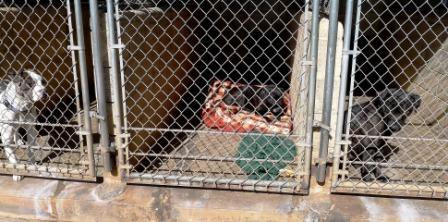
A growing number of animal shelters are taking the ‘no-kill’ vow. But it may not always be the most humane solution.
It is a question asked daily in animal shelters across this country. And given that millions of dogs and cats continue to be euthanized every year, the answer seems to be “kill.” But are there better options?
Until this century, stray pets were routinely collected by public animal-control departments (“dog catchers”) and destroyed, either by drowning or later in gas chambers, to prevent the spread of disease and to protect public safety. Pets historically served either a practical function, like controlling mice and protecting property, or were mere commodities and amusements. Spaying and neutering was uncommon, so the population of unwanted animals continued to grow. Municipal shelters were just crude holding facilities, and little thought was given to the well-being of the animals. By the end of the 20th century, the American shelter system was badly in need of reform.
Enter the “no-kill” movement, which officially began in 1998, when the state of California passed the Hayden Bill. This complex law basically required municipal shelters to hold animals for longer periods before euthanizing, to release them upon demand to rescue groups, and to perform spay/neuter before release. While it sounded good on paper, it resulted in massive overcrowding, animals becoming unadoptable due to stress-induced behavior, and deaths from fighting and disease. There was no control or oversight of how rescue groups dealt with issues such as adopting out aggressive dogs. The holding period requirements were suspended in 2009, but controversy continues over other aspects of the law.
Given that dogs, cats, and other animals today are often part of the family, rather than commodities or tools, it
is little wonder that a growing segment of the population has been quick to embrace the “no-kill” shelter model. But is it really the most humane solution?
‘Reasonable’ standards
That depends partly on what is meant by “no kill.” The extremist view literally means a refusal to take any animal’s life for any reason. A more pragmatic approach can be found in the principle of Utilitarianism, which states that the morally right course of action is that which produces the greatest good and the least harm to everyone affected. Maddie’s Fund (www.maddiesfund.org), formed in 1999 to support shelters striving for “no-kill” status, attempts to quantify this “greater good” by classifying animals as “healthy,” “unhealthy but treatable,” or “unhealthy and untreatable.” In principle, only the last category of animals would qualify for euthanasia.
The Fund guideline further states: “Shelters that save all healthy and treatable dogs and cats in their care are meeting the standard of care typically provided [by reasonable pet owners] in their own community. Shelters that go beyond this to save a portion of the ‘unhealthy & untreatable’ are exceeding their community’s standard of care and thus
setting an example of humane treatment.”
Maddie’s Fund leaves it up to each shelter to determine the degree of care “typically provided by reasonable and
caring pet owners/guardians in the community.” For example, The Animal Alliance of Portland, Oregon, assigns $750 as the cutoff point between “treatable” animals and those deemed “unhealthy/untreatable.”
This is where things get tricky, since we don’t all share the same values. While one person may be willing and able
to spend thousands of dollars for a dog’s hip replacement or chemotherapy, another might consider such expense and stress unreasonable for both dog and owner. And most people do not apply the same standards to shelter dogs as they do to their beloved family pets.
When it comes to setting standards for animal shelters, we are all likely to agree that a shelter should be clean,
well-managed, and safe for the animals. Most people support improvements such as extended adoption hours, promoting the use of identification, educating the public about the need to spay/neuter, and working cooperatively with rescue organizations. The main points of contention are how long an animal may spend in a shelter, and how much money is spent on rehabilitation or treatment. On these points, city-run “open” shelters and private “no-kill” shelters usually have very different standards.

A shell game?
The city shelter has little choice about what animals it takes in. “Open,” or unrestricted, intake helps discourage people from abandoning animals on the street, and offers an option for people who can no longer adequately provide for their pets. “No-kill” shelters, on the other hand, routinely use some type of screening process to reject animals that seem unadoptable, because they obviously cannot take all animals indefinitely. Thus, “no-kill” shelters do not reduce deaths so much as shift the burden elsewhere. From this perspective, it is questionable whether the “no-kill” model really serves the greater good.
There is also the question of funding. Most “no-kill” shelters are privately run, nonprofit organizations that are accountable to their donors, many of whom might consider it irresponsible to spend $3,000 on surgery for a single dog, when 10 or more could have received routine care with that same money. City shelters, too, are also limited by their taxpayer-financed budgets. To maximize the adoption chances of healthy animals, well-run shelters euthanize “unhealthy and untreatable” animals first.
Unfortunately, many still lack space for all the remaining animals—especially if the community has a large number of irresponsible pet owners. Many of the animals that end up in shelters are owner-surrendered. If these animals
are losing the homes they have, how can we expect there to be enough new homes for the animals in need?
Above: Albuquerque’s granddaddy of animal shelters, Animal Humane, reports that its euthanasia rate has fallen to less than 10 percent, and is near zero for healthy animals. Animal Humane is an open-admission shelter.
Freedom from suffering
Given these limitations, a blanket “no-kill” mandate may encourage “warehousing,” which creates its own problems for the animals. Consider the British Farm Animal Welfare Council’s “Five Freedoms of Animal Welfare,” written in 1965 and still used as a basic guideline to assess the quality of care provided in a shelter.

Five Freedoms of Animal Welfare
Freedom from thirst, hunger, and malnutrition.
Freedom from discomfort due to environment.
Freedom from pain, injury and disease.
Freedom to express normal behavior for the species.
Freedom from fear and distress.
The need for food and shelter is obvious and almost universally supplied. But some facilities do not provide adequate climate control, or use poor-quality, donated food contaminated by mice and other vermin. If an animal is suffering from pain, injury, or disease that cannot be remedied with a reasonable amount of time and effort, most people would consider humane euthanasia to be in the animal’s best interest.
The “freedom to express normal behavior” is clearly limited by the shelter environment, and extended stay in shelters may eventually render an animal unadoptable. Many or most animals experience some distress in shelters due
to confinement, noise, or abandonment. Well-run shelters attempt to minimize this, but the longer an animal spends
locked up, the greater the potential for permanent damage. Animals were not meant to live in cages. They need fresh
air, sunshine, exercise, socialization with their own kind, and mental stimulation to be healthy. The animal shelter is the equivalent of a human prison for those who have committed no crime.
With the introduction of the “no-kill” option, a hard question is raised: Is long-term imprisonment always preferable to death?
The answer depends on whether you consider death a final ending, or passage to another reality. The animals
themselves, of course, don’t fear death in the way that humans do, and it would appear that there are many kinds of suffering that are worse for them than death. Does our greater good also serve the greater good of the animals?
Above: A number of spaces at Corrales Kennels are leased or donated for rescue animals. Corrales last year made its “no-kill” philosophy a Village law, meaning no animals picked up will be euthanized for any reason. From left are rescue dogs Noodle, Bono, and Ben, all pit bull mixes. Bono has been at Corrales Kennels since last summer.
A human responsibility
Disagreeable as many people find the topic, the fact is that animal control still serves a necessary social and legal function. If humane treatment of animals is the goal, then euthanasia is arguably preferable to the many kinds of death endured by animals on the street, or continued suffering at the hands of irresponsible owners.
Whether a shelter achieves a high standard of humane treatment depends greatly on who runs it. Animal sheltering is a difficult job that involves difficult choices all the time, no matter how well a shelter is run. It is naïve for people to believe that every dog and cat off the street can find a loving home in a reasonable amount of time, especially animals that are old, sick, aggressive, or anxious. The ultimate irony is that behavior or mental health issues are rarely the fault of the animals.
We as a society may love our pets, but we are not behaving as responsible pet owners. We regularly expect our
pets to not behave like animals, to accept our lack of time for them, to just know not to potty in the house and destroy
our belongings, to not inconvenience us, and more. Large commercial breeding operations (“puppy mills”) are still in business because of consumer demand for pet store puppies. Every newspaper in the country has weekly examples of irresponsible, “backyard” breeding. We purchase or adopt puppies on a whim with little thought to how they fit our lifestyle or what we must do to meet their needs, and then dump them in shelters when they are no longer cute, fuzzy puppies and have failed to be educated properly. We have difficulty making long-term commitments to each other, let alone our pets. Until our society changes, animals will continue to die needlessly.
Certainly, the movement toward “no-kill” shelters reflects positively on the evolution of our thinking about animals. Laws are changing for the better, but continued discussion, education, and involvement are vital for further progress. Awareness has grown about reputable breeders, who sign a code of conduct with their breed clubs and agree to take back puppies any time for any reason. Quality shelters are working to reduce stress among the animals (and staff). But shelter organizations vary wildly in quality, and there is plenty of room for improvement. For example, 16 to 27 states still allow the use of gas chambers to kill unwanted animals.
We who truly care about animals must go beyond armchair policy-making and get involved, volunteer, donate,
and educate. Because “To kill or not to kill” is not the only question, but just one of many that remain to be answered.
